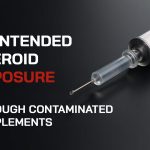Your basket is currently empty!
Category:
Anti-Doping Policies in the UFC and Steroids: Ensuring Fair Play in Mixed Martial Arts
November 16th, 2024 by anabolicpointThe world of professional sports, particularly in combat sports like mixed martial arts (MMA), has long been plagued by the use of performance-enhancing drugs (PEDs). In the UFC (Ultimate Fighting Championship), which is widely considered the pinnacle of MMA, the use of steroids and other PEDs has raised significant ethical, health, and fairness concerns. To combat the growing issue of doping, the UFC has implemented strict anti-doping policies aimed at preserving the integrity of the sport, ensuring fair competition, and safeguarding the health of its athletes.
The UFC’s anti-doping policies are designed not only to detect and deter the use of anabolic steroids but also to address other performance enhancers that could give fighters an unfair advantage. Despite these efforts, the world of MMA remains marred by ongoing controversies surrounding steroid use, testing procedures, and the consequences for those who violate anti-doping regulations.
This article will explore the UFC’s anti-doping policies, the role of steroids in MMA, and how the promotion and its fighters are working to tackle the issue of doping. We will also discuss the consequences of steroid use for fighters, the role of drug testing agencies like USADA (United States Anti-Doping Agency), and examine some of the most common questions surrounding the use of steroids in MMA.
The Rise of Steroid Use in MMA
In the early days of MMA, performance-enhancing drugs (PEDs) were often swept under the rug, as the sport was still developing and gaining mainstream recognition. However, as the UFC grew in popularity, so did concerns regarding steroid use and the potential for fighters to gain an unfair advantage through artificial means.
Steroids, specifically anabolic steroids, are commonly used by athletes across various sports to increase muscle mass, strength, and endurance. These benefits are especially appealing to MMA fighters, who rely on explosive strength and stamina to perform at their best during intense bouts. Steroids help athletes recover faster, build lean muscle mass, and potentially reduce the effects of fatigue, which can be critical in the high-paced, brutal nature of MMA.
The allure of steroids and other PEDs has led to significant cases of athletes testing positive for banned substances in the UFC. Fighters who test positive face a range of consequences, from fines and suspensions to stripping of titles, depending on the severity of the violation.
UFC’s Anti-Doping Policy: An Overview
The UFC took a bold step in addressing steroid use and doping when it entered into a partnership with the USADA in 2015 to implement a more stringent anti-doping program. USADA is an independent organization responsible for managing testing, enforcement, and education related to anti-doping practices. The UFC’s collaboration with USADA aims to eliminate PED use in MMA and maintain the integrity of the sport.
Under the UFC’s anti-doping policy, athletes are subjected to random drug tests both in and out of competition. These tests include urine and blood samples that are analyzed for various banned substances, including anabolic steroids, stimulants, human growth hormone (HGH), and other performance enhancers. The goal is to detect the use of PEDs that could give an unfair advantage to athletes and compromise the safety and integrity of competition.
The UFC’s anti-doping rules are comprehensive, and violations can result in serious consequences for fighters, including:
- Suspensions: Fighters who test positive for banned substances face suspensions ranging from a few months to several years, depending on the nature of the violation and whether it is a first-time or repeat offense.
- Fines: Fighters may also be fined a percentage of their earnings from the fight, with the amount varying based on the severity of the offense.
- Stripping of Titles and Awards: If a fighter is found guilty of doping, their title or award can be stripped, and any victories achieved while under the influence of banned substances can be nullified.
- Public Record: Fighters who violate anti-doping policies face damage to their reputation, as public disclosure of failed drug tests can tarnish their career and public image.
The UFC’s anti-doping policy also emphasizes education and awareness. Fighters are regularly educated on the substances and methods prohibited in MMA, and the importance of avoiding contaminated supplements is a central aspect of the program. This is particularly crucial in ensuring that athletes do not unintentionally violate anti-doping rules by consuming contaminated products.
Steroids and Their Impact on MMA Fighters
Steroids, including testosterone and its derivatives, are among the most commonly used PEDs in MMA. Fighters use these substances for various reasons, but primarily to increase strength, recover faster, and enhance muscle mass. Steroids can also provide mental benefits, including increased aggression and improved focus, which can be advantageous in a sport where mental toughness is just as important as physical skill.
However, the use of steroids comes with significant risks. Chronic steroid use can lead to a variety of health complications, including liver damage, cardiovascular issues, hormonal imbalances, and psychological side effects like aggression and mood swings. These risks not only threaten the long-term health of the athletes but can also compromise the safety of their opponents in the octagon. In a sport as physically demanding as MMA, where fighters are already at risk of injury, adding the dangers of steroid abuse can be catastrophic.
Additionally, steroid use in MMA raises significant ethical concerns. It creates an uneven playing field, where athletes who refrain from using PEDs are at a disadvantage compared to those who use them. This undermines the core principles of sportsmanship and fair competition and diminishes the skill-based nature of MMA, where the best fighter should emerge victorious based on their abilities, not on the substances they have ingested.
USADA and the UFC: A Partnership to Combat Doping
The UFC’s partnership with USADA was a pivotal moment in the fight against doping in MMA. USADA, a world-renowned anti-doping organization, conducts random and in-competition drug tests for all UFC athletes. This partnership aims to create a level playing field and maintain the credibility of the UFC brand by ensuring that all fighters compete without the aid of illegal substances.
USADA’s testing protocol includes both random and scheduled drug tests, with fighters subject to testing at any time, regardless of whether they are preparing for a fight. Athletes are required to provide detailed whereabouts information, which allows USADA to locate them for testing purposes. This approach makes it much more difficult for athletes to manipulate the system by using PEDs during training camps and stopping just before their scheduled tests.
USADA also works with the UFC to provide education programs for fighters, trainers, and managers. These programs cover the dangers of doping, how to avoid banned substances, and the importance of clean competition. USADA’s role is crucial in ensuring that the UFC remains a clean and fair organization where talent and hard work are the primary factors determining success.
High-Profile Cases of Steroid Violations in the UFC
Despite the UFC’s stringent anti-doping policies, steroid use remains a significant issue. Over the years, several high-profile fighters have tested positive for banned substances, leading to suspensions, fines, and other consequences. These cases highlight the ongoing challenges of maintaining a clean sport and the lengths to which some athletes will go to gain an edge over their competition.
One of the most infamous cases of steroid use in the UFC involved former UFC light heavyweight champion Jon Jones. In 2015, Jones tested positive for a banned substance (clomiphene) and was stripped of his title. Jones’ case is particularly notable because of his status as one of the greatest fighters of all time. His suspension and subsequent battles with the UFC over doping-related issues sparked widespread debate about the prevalence of PEDs in MMA and the effectiveness of the UFC’s anti-doping policies.
Another high-profile case involved former UFC heavyweight champion Brock Lesnar. Lesnar tested positive for clomiphene following his UFC 200 bout against Mark Hunt in 2016. His victory was overturned, and he was handed a suspension by USADA. Lesnar’s case further fueled the debate about the use of PEDs in MMA, especially among fighters coming from professional wrestling backgrounds, where steroid use has been a longstanding issue.
While these cases are just a few examples, they underscore the ongoing challenges of keeping doping in check in the UFC and other professional sports. They also illustrate the importance of strong anti-doping policies and the need for continued vigilance in the fight against performance-enhancing drugs.
Frequently Asked Questions (FAQs)
- What is the UFC’s stance on steroid use? The UFC has a strict anti-doping policy, and the use of steroids and other performance-enhancing drugs is prohibited. Fighters who are caught using these substances face suspensions, fines, and other penalties.
- How does the UFC test for steroids? The UFC works with USADA to conduct random and scheduled drug tests. Fighters are subject to both urine and blood tests, which check for banned substances like anabolic steroids, HGH, and stimulants.
- What happens if a UFC fighter tests positive for steroids? Fighters who test positive for steroids face various penalties, including suspensions, fines, and the stripping of titles. Their victories may also be overturned, and their public reputation can suffer significant damage.
- How effective is the UFC’s anti-doping program? While the UFC’s anti-doping program, managed by USADA, has been highly effective in identifying violations and enforcing penalties, there are still instances of steroid use and other doping issues within the sport.
- What substances are banned in the UFC? The UFC, in collaboration with USADA, follows the World Anti-Doping Agency’s (WADA) list of prohibited substances, which includes anabolic steroids, stimulants, human growth hormone (HGH), and blood doping agents.
- Are there any exceptions to the UFC’s anti-doping policy? In certain cases, fighters may apply for a therapeutic use exemption (TUE) if they require a banned substance for medical reasons. However, these exemptions are rare and are subject to strict approval processes.
- What are the health risks of steroid use in MMA? Steroid use can lead to a variety of health risks, including liver damage, cardiovascular issues, hormonal imbalances, and psychological side effects like aggression and mood swings.
- Why do some fighters use steroids in MMA? Fighters may use steroids to increase muscle mass, enhance strength, speed up recovery, and gain a competitive edge in the physically demanding sport of MMA.
- How long is a fighter suspended for a positive steroid test? Suspension lengths vary based on the severity of the offense, ranging from several months to multiple years for repeat offenders. First-time offenders typically face shorter suspensions.
- Can a fighter’s career be ruined by a steroid violation? A steroid violation can have serious consequences for a fighter’s career, including suspension, loss of sponsorships, damage to reputation, and financial losses due to overturned victories and fines.
Final Reflections: The Future of Anti-Doping in the UFC
The UFC’s anti-doping policies are essential for maintaining fairness, safety, and the integrity of the sport. While progress has been made in the fight against steroid use and performance-enhancing drugs, ongoing vigilance is required to combat doping. The partnership with USADA has significantly improved testing protocols and transparency, but the fight against PEDs in MMA is far from over. Athletes, fans, and the organization must continue to work together to ensure a clean and competitive sport where hard work, dedication, and skill are the true determinants of success.
The Shadows of Controversy: Steroid Cases in Combat Sports
November 16th, 2024 by anabolicpointCombat sports have long been celebrated for showcasing the pinnacle of human endurance, power, and skill. From boxing to mixed martial arts (MMA), the spectacle lies in the raw clash of strength and strategy. However, the integrity of these sports has often been called into question due to the persistent shadow of performance-enhancing drugs (PEDs), especially anabolic steroids. These substances, designed to boost muscle mass and improve recovery times, have been at the heart of some of the most contentious scandals in combat sports history.
Steroid controversies have not only marred the reputations of prominent fighters but also stirred debates about ethics, fairness, and athlete safety. This article delves into the prevalence of steroids in combat sports, the most notorious cases, and the broader implications of these controversies.
The Role of Steroids in Combat Sports
Anabolic steroids mimic the effects of testosterone, a hormone responsible for muscle growth, strength, and endurance. While they can be legally prescribed for certain medical conditions, their misuse in sports stems from their ability to offer an unfair advantage. Athletes often turn to these substances to recover faster from injuries, enhance their training intensity, and maintain peak performance levels.
In combat sports, where milliseconds can determine victory, such enhancements can tilt the scales in one fighter’s favor. This not only jeopardizes the opponent’s safety but also undermines the sport’s integrity.
Notable Steroid Scandals in Combat Sports
Several high-profile cases have highlighted the steroid problem in combat sports. Here are some of the most infamous incidents:
1. Anderson Silva (MMA)
Known as one of the greatest fighters in MMA history, Anderson Silva’s legacy took a hit when he tested positive for anabolic steroids drostanolone and androsterone in 2015. Silva claimed his use was unintentional and linked it to a tainted supplement, but the scandal led to a suspension and tarnished his once-impeccable career.
2. Jon Jones (MMA)
Jon Jones, often considered one of MMA’s most gifted athletes, has faced multiple controversies involving PEDs. In 2017, he tested positive for Turinabol, a banned anabolic steroid, leading to the stripping of his UFC light heavyweight title. Jones’ repeated infractions have sparked debates about leniency and consistency in doping punishments.
3. Jarrell Miller (Boxing)
Boxer Jarrell “Big Baby” Miller was on the cusp of a career-defining fight against Anthony Joshua in 2019 when he tested positive for multiple banned substances, including GW1516, HGH, and EPO. The scandal cost him his title shot and spotlighted the extent of PED use in boxing.
4. T.J. Dillashaw (MMA)
Former UFC bantamweight champion T.J. Dillashaw tested positive for recombinant human erythropoietin (EPO) in 2019. EPO boosts red blood cell production, enhancing oxygen delivery and endurance. Dillashaw’s admission of guilt and subsequent suspension sent shockwaves through the MMA community.
5. Canelo Álvarez (Boxing)
Mexican boxing superstar Canelo Álvarez tested positive for clenbuterol in 2018. Canelo attributed the result to contaminated meat, a common issue in Mexico, but the scandal fueled criticism about the sport’s testing protocols.
The Challenges of Doping Control
Despite stringent anti-doping measures, the use of steroids and other PEDs persists. This raises questions about the effectiveness of testing and the motivations driving athletes toward banned substances.
Testing Limitations
While agencies like the United States Anti-Doping Agency (USADA) and the World Anti-Doping Agency (WADA) have robust testing protocols, athletes often exploit loopholes. Some substances can clear from the system within hours, making timing critical. Micro-dosing and designer steroids, which are harder to detect, further complicate enforcement.
Cultural and Financial Pressures
The immense financial rewards and fame associated with combat sports can push athletes to seek any edge, even if it means compromising their health and ethics. Additionally, the culture of some training camps or promotions may implicitly encourage PED use to remain competitive.
Rehabilitation and Redemption
Many fighters caught in steroid scandals seek redemption through public apologies, clean records post-suspension, or improved performances without PEDs. However, the stigma often lingers, as fans and analysts question whether their achievements were legitimate.
Impact on Fighters and Fans
The fallout of steroid scandals is multifaceted. For fighters, being caught with PEDs often leads to suspensions, financial penalties, and loss of endorsements. For fans, these controversies erode trust in the sport. Each scandal reminds audiences that what they see in the ring or cage might not always be natural, dampening the authenticity of the competition.
Steroid Myths vs. Realities in Combat Sports
Several misconceptions about steroids and their role in combat sports persist:
- Myth: Steroids guarantee victory.
Reality: While steroids enhance physical attributes, skill, strategy, and mental toughness are equally crucial in combat sports. - Myth: All successful fighters use steroids.
Reality: Many athletes achieve greatness through natural talent and hard work, disproving the notion that PEDs are ubiquitous at the top level. - Myth: Steroids are harmless in moderation.
Reality: Even low doses can have severe side effects, including heart disease, liver damage, and hormonal imbalances.
A Path Forward: Striking a Balance
To combat the steroid problem, a multi-pronged approach is needed:
- Enhanced Testing:
Investing in advanced testing technologies can close loopholes and deter athletes from using newer PEDs. - Education:
Fighters need comprehensive education about the health risks of steroids and the ethical implications of doping. - Stricter Penalties:
Uniform and severe consequences for violations can dissuade potential offenders. - Cultural Shift:
Promoting a culture of clean competition, with endorsements and promotions prioritizing integrity over wins, is essential.
The Ripple Effect of Steroid Use
Beyond the athletes, steroid controversies affect sponsors, promotions, and even amateur athletes. Sponsors often distance themselves from tainted fighters, while promotions must navigate the legal and reputational fallout. For aspiring fighters, the perception of widespread PED use can create a dangerous precedent, normalizing unethical practices.
Future of Combat Sports Without Steroids
The ultimate goal is to create a level playing field where skill and dedication prevail over artificial enhancements. While complete eradication of steroid use may be unrealistic, minimizing its prevalence can restore faith in the fairness of competition. Combat sports must continuously adapt to the evolving challenges of PED use, ensuring that integrity remains at the heart of every contest.
Questions and Answers
1. Why are steroids used in combat sports?
Steroids enhance strength, endurance, and recovery, giving athletes a competitive edge.
2. What are the most common steroids found in doping cases?
Common steroids include testosterone, drostanolone, and Turinabol.
3. How do steroids affect a fighter’s performance?
They improve muscle mass, speed up recovery, and boost overall physical performance.
4. What are the health risks of steroid use?
Risks include heart disease, liver damage, hormonal imbalances, and psychological effects.
5. How do anti-doping agencies detect steroids?
Agencies use urine and blood tests to identify banned substances or their metabolites.
6. Why do some fighters deny steroid use despite positive tests?
Denials often stem from fear of reputational damage, contractual penalties, or admission of guilt.
7. Can fighters recover their reputation after a steroid scandal?
While redemption is possible, the stigma often lingers, impacting public perception.
8. What role do promotions play in controlling steroid use?
Promotions can enforce stricter testing, educate fighters, and promote clean competition.
9. Are there legal consequences for steroid use in combat sports?
Legal consequences vary by jurisdiction but may include fines, suspensions, or bans.
10. What’s the future of anti-doping measures in combat sports?
Advances in testing and a cultural shift toward clean competition are critical for reducing PED use.
A Legacy Worth Fighting For
Steroid use in combat sports is a complex issue, entwined with human ambition, financial pressures, and ethical dilemmas. By understanding the roots of the problem and fostering a culture of integrity, the sporting community can ensure that every fight represents the pure essence of competition. The battle against PEDs is ongoing, but the fight for fair play is one worth championing.
Steroids and Explosive Power in Striking Sports: Unveiling the Effects, Risks, and Alternatives
November 16th, 2024 by anabolicpointStriking sports such as boxing, kickboxing, Muay Thai, and mixed martial arts (MMA) require athletes to generate explosive power in their strikes. Whether it’s delivering a knockout punch, a swift kick, or a devastating knee strike, the ability to execute powerful moves is crucial for success. In the pursuit of enhancing this explosive power, some athletes turn to performance-enhancing drugs (PEDs), particularly anabolic steroids. These substances are believed to amplify strength, speed, and muscle endurance, thereby potentially improving an athlete’s striking power.
However, while steroids may offer short-term benefits, they come with significant risks, and their use raises ethical and health concerns. In this article, we will explore the relationship between anabolic steroids and explosive power in striking sports, examining how these drugs affect athletic performance, the potential risks involved, and the ethical considerations surrounding their use in sports.
Understanding Steroids and Explosive Power
Anabolic steroids are synthetic derivatives of the male sex hormone testosterone. These substances primarily work by stimulating muscle growth, increasing strength, and enhancing recovery. In the context of striking sports, the goal is to enhance an athlete’s ability to generate force quickly and efficiently. Explosive power is a combination of strength and speed, where the muscles generate maximum force in the shortest amount of time. This is crucial in sports like boxing or MMA, where a fighter’s ability to land a powerful strike can determine the outcome of a fight.
When it comes to the impact of anabolic steroids on explosive power, there are several ways in which they are believed to help:
- Increased Muscle Mass and Strength
Anabolic steroids promote muscle hypertrophy (growth), which directly translates to increased muscle strength. In striking sports, stronger muscles mean more powerful punches, kicks, and other forms of striking. Enhanced muscle mass allows athletes to generate more force during a strike, improving both speed and power. - Improved Muscle Recovery
One of the major benefits of anabolic steroids is their ability to accelerate recovery. Striking sports require intense training sessions, and athletes often need to recover quickly in order to train harder or compete more frequently. Steroids help by reducing muscle damage and inflammation, enabling athletes to engage in high-intensity training more often without experiencing excessive fatigue. - Enhanced Nervous System Efficiency
Steroids have been shown to improve the efficiency of the central nervous system (CNS), which plays a key role in muscle contractions. This means athletes can generate quicker and more powerful movements, improving their reaction time and the overall explosiveness of their strikes. The ability to activate muscle fibers more efficiently allows for more forceful strikes in a shorter time. - Increased Red Blood Cell Production
Some steroids can boost the production of red blood cells, which are responsible for carrying oxygen throughout the body. With more red blood cells, an athlete’s muscles receive more oxygen during high-intensity bouts, which reduces fatigue and allows them to maintain explosive power for longer periods of time. - Improved Focus and Aggression
Anabolic steroids can increase aggression and mental focus, which are essential in striking sports. Athletes may feel more confident and focused during competition, allowing them to commit fully to their punches and kicks. The enhanced aggression can lead to more forceful attacks, although it can also result in reckless behavior if not carefully controlled.
The Role of Steroids in Popular Striking Sports
In sports like boxing, kickboxing, Muay Thai, and MMA, the need for explosive power is central to success. Below, we’ll explore how steroids may influence performance in these sports.
- Boxing: In boxing, an athlete’s ability to throw powerful punches while maintaining speed and endurance is crucial. Steroids can enhance strength, allowing boxers to deliver knockout punches with greater force. Additionally, steroids can improve muscle recovery, enabling boxers to train harder and more often. However, while steroids may help a boxer’s explosive power, they can also affect cardiovascular health, making it harder for athletes to sustain their power through long bouts.
- Kickboxing: Similar to boxing, kickboxers rely on explosive strikes, such as powerful punches and high, roundhouse kicks. Steroids can aid kickboxers by increasing the muscle mass in the legs and core, which are crucial for delivering powerful kicks. The enhanced muscle recovery from steroids can also allow kickboxers to increase the frequency and intensity of their training, improving their performance in the ring.
- Muay Thai: Known as the “art of eight limbs,” Muay Thai requires athletes to deliver strikes using fists, elbows, knees, and shins. Steroids can increase the strength and endurance needed for these diverse strikes. Additionally, the added aggression and mental focus induced by steroids can help fighters maintain a high level of intensity throughout a fight, crucial for clinch battles and delivering effective knee strikes.
- Mixed Martial Arts (MMA): MMA combines elements of boxing, kickboxing, wrestling, and Brazilian Jiu-Jitsu. Fighters need to possess explosive power in both their striking and grappling techniques. Anabolic steroids can enhance both the striking power of MMA athletes and their ability to recover from intense training sessions, which helps with maintaining high levels of explosiveness over the course of a long fight. However, the use of steroids in MMA is not without its risks, as it can also lead to increased aggression and poor decision-making in the heat of a battle.
The Risks and Side Effects of Steroid Use in Striking Sports
While the use of anabolic steroids in striking sports may promise to boost power and performance, the potential risks are considerable. These risks not only affect the athlete’s health but can also have lasting consequences for their career and well-being.
- Cardiovascular Issues
Steroid use has been linked to increased risks of heart disease, high blood pressure, and stroke. Steroids can alter cholesterol levels, increasing LDL (bad cholesterol) and decreasing HDL (good cholesterol). This can lead to the buildup of plaque in the arteries, increasing the risk of heart attacks and other cardiovascular problems. - Liver Damage
Many anabolic steroids, particularly oral forms, are hepatotoxic, meaning they can damage the liver. Prolonged use can lead to liver enlargement, jaundice, and in extreme cases, liver failure or cancer. The liver plays a vital role in detoxifying the body, and the added stress from steroid use can compromise its function. - Hormonal Imbalances
Anabolic steroids can interfere with the body’s natural production of hormones, particularly testosterone. For men, this can lead to testicular shrinkage, reduced sperm count, and infertility. In women, steroids can cause masculine traits such as facial hair growth, deepened voice, and menstrual irregularities. - Psychological Effects
Steroid use is associated with increased aggression, known as “roid rage.” This can cause emotional instability, irritability, anxiety, and even violent outbursts. Such psychological effects can interfere with a fighter’s ability to make sound decisions during a fight, leading to reckless actions and a higher risk of injury. - Increased Risk of Injury
While steroids can increase muscle mass and strength, they do not strengthen tendons, ligaments, and joints. This can result in an increased risk of injury, especially in high-impact sports like boxing or MMA, where athletes are constantly under stress. The added muscle mass may also limit an athlete’s flexibility and agility, affecting their overall performance.
The Ethical Debate Around Steroid Use in Striking Sports
Steroid use in striking sports raises significant ethical issues. The primary concern is fairness. Steroids provide an unfair advantage to athletes who use them, as they can enhance strength, recovery, and endurance in ways that naturally talented athletes cannot achieve without chemical assistance. This creates an uneven playing field and undermines the integrity of the competition.
In addition, the risks associated with steroid use are not only personal but also affect the sport as a whole. When athletes use steroids, they are promoting the idea that performance is reliant on drugs rather than hard work, talent, and discipline. This can influence younger athletes and beginners, leading them to believe that they need steroids to succeed in their sport.
Moreover, the long-term health risks associated with steroids should not be overlooked. The pressure to perform at the highest level in striking sports is immense, but it should never come at the expense of an athlete’s health. The potential for cardiovascular disease, liver damage, and hormonal imbalances is significant and should be a serious deterrent for anyone considering steroid use.
Alternatives to Steroid Use for Explosive Power
While steroids may seem like an easy shortcut to explosive power, there are safer, more sustainable ways to enhance performance in striking sports. These include:
- Strength Training: Building explosive power through weight training exercises such as squats, deadlifts, and power cleans can improve the force generated during strikes. Plyometric exercises, such as box jumps and medicine ball throws, can also help improve explosive strength.
- Speed and Agility Training: Incorporating speed and agility drills into a training routine can help athletes increase their reaction times and overall explosiveness.
- Proper Nutrition: A well-balanced diet rich in proteins, healthy fats, and carbohydrates provides the necessary fuel for intense training and competition. Supplements like creatine, beta-alanine, and branched-chain amino acids (BCAAs) can also support muscle strength and endurance.
- Recovery and Rest: Adequate sleep and active recovery are essential for muscle growth and performance. Overtraining can lead to fatigue and injury, which can hinder the development of explosive power.
- Mental Conditioning: Focus, visualization, and relaxation techniques can help athletes maintain control and mental clarity during high-intensity bouts. A calm and focused mind allows for more effective and powerful strikes.
Frequently Asked Questions
- Do steroids really improve explosive power in striking sports? Yes, steroids can increase muscle mass, strength, and recovery, which can lead to improved explosive power. However, they come with significant health risks.
- What are the most common side effects of steroid use in athletes? Steroid use can lead to cardiovascular issues, liver damage, hormonal imbalances, psychological effects like aggression, and an increased risk of injury.
- How do steroids affect muscle recovery? Steroids enhance muscle recovery by reducing inflammation and muscle damage, allowing athletes to train harder and more frequently.
- What are the ethical concerns regarding steroid use in striking sports? Steroid use undermines the fairness of competition, creates an uneven playing field, and promotes the idea that performance is reliant on drugs rather than talent and hard work.
- Can explosive power be improved without steroids? Yes, through strength training, speed drills, proper nutrition, rest, and mental conditioning, athletes can enhance their explosive power safely and effectively.
- What types of steroids are most commonly used by athletes? Some commonly used steroids include testosterone, nandrolone, stanozolol, and dianabol. These are typically used to increase muscle mass, strength, and endurance.
- Do steroids affect mental focus and aggression? Yes, steroids can increase aggression, leading to “roid rage” and affecting an athlete’s mental focus and decision-making abilities during a fight.
- How do steroids influence cardiovascular health in athletes? Steroid use can lead to high blood pressure, heart disease, and an increased risk of stroke, particularly with prolonged use.
- What are the long-term effects of steroid use in striking sports? Long-term steroid use can lead to serious health issues like liver damage, heart disease, hormonal imbalances, infertility, and psychological problems.
- What alternatives exist to steroids for enhancing power in striking sports? Natural methods, such as strength training, plyometric exercises, proper nutrition, rest, and mental conditioning, can significantly improve an athlete’s explosive power without the health risks associated with steroids.
Final Thoughts: Navigating the Fine Line Between Performance Enhancement and Health
While anabolic steroids may offer an avenue to increased explosive power in striking sports, the risks far outweigh the benefits. Their use comes with serious health implications that can hinder not only an athlete’s career but also their long-term well-being. Instead of turning to steroids, athletes should focus on natural training methods, proper nutrition, and recovery techniques to enhance their performance in a safe and sustainable manner. Ultimately, the most powerful athletes are those who combine discipline, hard work, and dedication to achieve their goals.
The Role of Steroids in Recovery from Fight Injuries: A Deep Dive into Controversial Healing Methods
November 16th, 2024 by anabolicpointCombat sports like boxing, mixed martial arts (MMA), and wrestling are brutal by nature, subjecting athletes to a high risk of injuries. From fractures and sprains to deep tissue damage, fighters often endure severe physical trauma during training and competition. Speedy recovery is crucial in their profession, as prolonged downtime can lead to missed opportunities, financial strain, and loss of competitive edge.
Steroids, particularly anabolic steroids, have been studied for their ability to enhance recovery and promote tissue repair. While these substances are widely recognized for their performance-enhancing effects, their role in injury recovery is a topic of significant debate. This article explores how steroids contribute to recovery from fight-related injuries, the science behind their effects, and the ethical and medical implications of their use.
Understanding the Basics of Steroids in Recovery
Steroids are synthetic compounds designed to mimic the functions of naturally occurring hormones. Two primary types of steroids are commonly discussed in the context of recovery:
- Anabolic Steroids: These promote muscle growth and tissue repair, making them appealing for recovery. They enhance protein synthesis, leading to faster regeneration of damaged tissues.
- Corticosteroids: Often prescribed medically, these reduce inflammation and immune response, helping to manage pain and swelling in acute injuries.
While corticosteroids are frequently used in clinical settings, anabolic steroids are more controversial due to their potential for abuse and long-term side effects. Fighters considering anabolic steroids for recovery face not only medical risks but also ethical and regulatory hurdles, as their use is often prohibited in sports.
How Steroids Aid Recovery from Fight Injuries
The role of steroids in recovery is multi-faceted, encompassing muscle repair, inflammation control, and overall physical restoration.
Accelerated Tissue Repair
Anabolic steroids boost the body’s ability to repair muscle tissue by increasing the rate of protein synthesis. This process is vital for fighters recovering from muscle tears, ligament injuries, and other soft tissue damage commonly sustained in combat sports.
Reduction of Inflammation
Corticosteroids, when used appropriately, are effective in reducing inflammation associated with injuries like sprains, tendonitis, or joint damage. By controlling inflammation, they alleviate pain and improve mobility, allowing fighters to begin rehabilitation sooner.
Bone Healing
Certain studies suggest that anabolic steroids can enhance bone density and accelerate the healing of fractures. This is particularly beneficial for fighters who suffer broken bones during bouts or training.
Improved Recovery from Overtraining
Combat athletes are prone to overtraining syndrome, which results in chronic fatigue, muscle soreness, and a weakened immune system. Steroids may mitigate these effects by promoting faster muscle recovery and reducing the impact of accumulated stress.
Medical Applications vs. Abuse in Sports
Steroids can be legally prescribed for injury recovery under medical supervision. For instance, corticosteroid injections are common treatments for joint pain and inflammation. However, the misuse of anabolic steroids to gain a competitive advantage or recover faster than natural processes would allow raises ethical and health concerns.
Therapeutic Use
Medically supervised steroid treatments can be part of legitimate recovery plans. Physicians prescribe corticosteroids for acute injuries and specific conditions like bursitis or arthritis. In rare cases, anabolic steroids may be used to treat severe muscle-wasting injuries or conditions.
Abuse in Combat Sports
The unsanctioned use of anabolic steroids among fighters is often driven by the desire to return to competition quickly. Fighters may self-administer steroids in doses far exceeding medical recommendations, increasing their risk of side effects and violating anti-doping regulations.
Risks Associated with Steroid Use for Recovery
While steroids may offer short-term recovery benefits, their misuse can lead to significant health complications and career-ending consequences.
Physical Health Risks
- Hormonal Imbalances: Long-term anabolic steroid use disrupts natural hormone production, leading to testosterone suppression, infertility, and other endocrine issues.
- Cardiovascular Problems: Steroids can elevate blood pressure, cholesterol levels, and the risk of heart disease.
- Liver Damage: Oral anabolic steroids are particularly taxing on the liver, potentially causing long-term damage or tumors.
- Muscle and Tendon Weakness: Steroids may promote rapid muscle growth that outpaces the strength of tendons, increasing the risk of tears.
Psychological Effects
Steroid use has been linked to mood swings, aggression, and depression. Fighters already under stress may find these effects particularly debilitating.
Ethical and Legal Consequences
Most combat sports organizations, including the UFC and boxing commissions, prohibit anabolic steroids. Athletes caught using them face suspensions, fines, and reputational damage.
Steroids vs. Natural Recovery Methods
For fighters seeking recovery without the risks associated with steroids, numerous natural and medically sanctioned alternatives exist.
- Physical Therapy: Customized rehabilitation programs focus on restoring strength, flexibility, and function in injured areas.
- Nutrition and Supplements: Diets rich in protein, omega-3 fatty acids, and antioxidants, along with supplements like collagen and creatine, can aid recovery.
- Advanced Therapies: Techniques like platelet-rich plasma (PRP) therapy, stem cell treatments, and cryotherapy are gaining traction as effective recovery methods.
While these methods may require more time and effort, they align with ethical sportsmanship and long-term health.
Steroid Use in Recovery: A Divided Opinion
The debate over using steroids for recovery highlights the tension between medical necessity and athletic integrity. Some argue that under controlled circumstances, steroids could be a legitimate tool for helping fighters recover from severe injuries. Others maintain that any use of anabolic steroids undermines the principles of fair play and opens the door to abuse.
Proponents’ Perspective
Advocates for steroid use in recovery point to the potential for faster rehabilitation and a reduced risk of chronic injuries. They argue that medically supervised use minimizes risks while allowing athletes to regain their livelihoods.
Opponents’ Perspective
Critics emphasize the long-term health consequences and the slippery slope of normalizing steroid use. They stress the importance of natural recovery methods and stricter enforcement of anti-doping regulations.
Questions and Answers About Steroids in Recovery from Fight Injuries
- What are steroids used for in injury recovery?
Steroids help reduce inflammation, promote tissue repair, and accelerate recovery from muscle or joint injuries. - Are steroids legal for injury recovery in sports?
Corticosteroids may be used under medical supervision, but anabolic steroids are generally banned in competitive sports. - How do steroids help muscle recovery?
Anabolic steroids enhance protein synthesis, speeding up the repair and growth of muscle tissue after injury. - What are the risks of using steroids for recovery?
Risks include hormonal imbalances, cardiovascular problems, liver damage, and psychological effects like mood swings. - Can steroids help with bone healing?
Some studies suggest anabolic steroids may promote bone density and speed up fracture healing. - What is the difference between anabolic steroids and corticosteroids?
Anabolic steroids promote muscle growth, while corticosteroids reduce inflammation and immune response. - Are there natural alternatives to steroids for recovery?
Yes, options include physical therapy, proper nutrition, supplements, and advanced treatments like PRP therapy. - What happens if a fighter is caught using steroids?
Consequences include suspensions, fines, loss of titles, and reputational damage. - How long do steroids stay in the system?
Detection times vary depending on the type of steroid, dosage, and administration method but can range from weeks to months. - Do steroids have long-term effects?
Yes, prolonged use can cause irreversible health issues, including cardiovascular disease, liver damage, and hormonal disruptions.
Paving the Way for Ethical Recovery
The use of steroids in recovery from fight injuries remains a complex issue, balancing medical potential against ethical and health concerns. While these substances may offer short-term benefits, the risks and long-term consequences often outweigh their advantages. Combat sports must continue to prioritize education, transparency, and innovation in natural recovery methods, ensuring fighters can heal effectively without compromising their integrity or health. For athletes, embracing clean recovery practices is not just about maintaining compliance—it’s a commitment to their sport, their peers, and their future.
Steroids and Endurance in Combat Sports: Analyzing the Impact and Risks
November 16th, 2024 by anabolicpointEndurance is a crucial element in combat sports such as boxing, MMA, kickboxing, and wrestling. Athletes in these sports often find themselves in high-intensity bouts that test not just their strength and technique but their ability to sustain energy over extended periods. While natural endurance is developed through rigorous training, some athletes turn to performance-enhancing drugs (PEDs), particularly anabolic steroids, to gain a competitive edge. The use of steroids in combat sports raises important questions about their impact on endurance, as well as the associated risks and ethical considerations.
This article delves into the relationship between steroids and endurance in combat sports, examining how anabolic steroids may enhance performance, the risks of their use, and the legal and ethical issues surrounding their application in high-level competition.
What Are Steroids and How Do They Affect the Body?
Anabolic steroids, also known as anabolic-androgenic steroids (AAS), are synthetic substances designed to mimic the effects of the male hormone testosterone. These compounds have two primary effects: anabolic, which promotes muscle growth, and androgenic, which influences male traits such as facial hair and voice deepening. Anabolic steroids are often used by athletes and bodybuilders to enhance muscle mass, strength, and overall performance.
In terms of endurance, steroids work in several ways to support athletes’ efforts in combat sports:
- Increased Red Blood Cell Production
Anabolic steroids can stimulate the production of red blood cells in the body, which improves the blood’s ability to carry oxygen. This increased oxygen delivery allows muscles to work more efficiently during high-intensity activity, delaying the onset of fatigue. For combat athletes, this means they can maintain power, speed, and technique over extended rounds or during intense sparring sessions. - Improved Muscle Recovery
Steroids accelerate the recovery process by enhancing protein synthesis, which aids muscle repair after strenuous training or competition. This helps combat sports athletes recover faster, allowing them to train harder and more frequently without experiencing prolonged muscle soreness or fatigue. - Enhanced Strength and Power
Steroids contribute to the development of lean muscle mass, which enhances overall strength and power. This additional strength allows athletes to perform more explosive actions, such as powerful strikes, takedowns, and clinch maneuvers. The enhanced muscle mass and strength also contribute to stamina, as athletes are better equipped to withstand the physical demands of long bouts. - Reduced Fatigue
One of the key benefits of steroids in combat sports is their ability to reduce fatigue. Steroids work by increasing the body’s ability to process nutrients and recover from stress, making it easier for athletes to maintain their energy during high-intensity efforts. For example, in a prolonged fight or extended training session, steroids can help combatants maintain their pace without experiencing the usual signs of fatigue such as muscle cramping or weakness.
Combat Sports That Benefit from Steroid-Induced Endurance
Different combat sports require different levels of endurance, strength, and explosiveness. While steroids are generally banned in all professional combat sports, their use is most common in sports where endurance plays a key role. These include:
- Mixed Martial Arts (MMA): MMA fighters must be able to sustain their performance throughout the fight, which can last for up to five rounds in championship bouts. Steroids can help fighters maintain power, speed, and strength as they grapple, strike, and wrestle throughout the fight.
- Boxing: Boxing requires both aerobic and anaerobic endurance. Fighters need to maintain speed and power over several rounds of intense combat. Steroids can improve stamina and recovery, which is why some boxers have used them to gain an edge in training and competition.
- Kickboxing: Like boxing, kickboxing involves high-intensity combat with the added complexity of kicking. Endurance is critical in both standing and ground exchanges, and steroids can help fighters maintain energy levels through rounds of strikes and defensive maneuvers.
- Wrestling: Wrestlers need strength, speed, and stamina to compete at high levels. Steroids can contribute to improved endurance and recovery, allowing wrestlers to engage in multiple matches or longer training sessions without tiring.
- Muay Thai: Known for its grueling striking techniques, Muay Thai requires exceptional endurance to keep up with the constant demand for strikes and defense. Steroid use can help athletes in Muay Thai prolong their endurance through repeated strikes and clinches.
The Ethical Debate on Steroid Use in Combat Sports
Steroids are banned in nearly all professional combat sports due to the unfair advantage they offer and the potential health risks they pose. The ethical concerns surrounding steroid use are wide-ranging and have led to the establishment of anti-doping agencies in most sports organizations. These agencies conduct regular testing to ensure that athletes compete on a level playing field.
The core ethical argument against steroid use is centered around fairness. Combat sports rely on skill, strategy, and physical conditioning, and many believe that using steroids to enhance performance gives athletes an unfair advantage over their natural counterparts. The use of performance-enhancing drugs can skew competition, particularly when athletes who do not use steroids are forced to compete against those who have the added benefit of increased endurance and strength.
Steroid use also undermines the integrity of sport, as it shifts the focus from hard work, natural talent, and mental toughness to chemical enhancement. This can send a harmful message to younger athletes and fans, leading them to believe that success is reliant on drugs rather than dedication.
Moreover, using steroids comes with serious health risks, including cardiovascular issues, liver damage, hormonal imbalances, and psychological effects. This has led many to argue that steroid use is dangerous, especially when young athletes may be inclined to follow the example set by those who use performance-enhancing drugs.
The Risks of Steroid Use in Combat Sports
Although steroids can enhance endurance, the risks associated with their use are significant and should not be overlooked. These risks include:
- Cardiovascular Issues
Steroid use is associated with an increased risk of heart disease, hypertension (high blood pressure), and heart attacks. These compounds can increase levels of bad cholesterol (LDL) and decrease levels of good cholesterol (HDL), leading to an elevated risk of developing cardiovascular problems. - Hormonal Imbalance
Anabolic steroids can disrupt the body’s natural hormone production. In men, they can suppress testosterone levels, leading to side effects such as testicular shrinkage, infertility, and reduced libido. In women, steroids can cause masculinizing effects like deepening of the voice, facial hair growth, and changes in menstrual cycles. - Liver Damage
Steroids, particularly oral ones, can cause liver toxicity. Long-term use can result in liver damage, jaundice, and liver cancer. The liver plays a crucial role in detoxifying the body, and the stress caused by steroids can significantly impair its function. - Psychological Effects
Steroids can have a negative impact on mental health. Known as “roid rage,” steroid use has been linked to increased aggression, mood swings, anxiety, and depression. These psychological side effects can impair an athlete’s judgment and behavior, both in and out of competition. - Increased Risk of Injury
Although steroids can increase muscle mass and strength, they do not necessarily strengthen ligaments and tendons. This can result in a higher risk of injury, particularly in combat sports, where joint stress and impact are frequent. The increased muscle mass may also make athletes less agile, affecting their ability to react quickly.
Testing and Detection of Steroid Use in Combat Sports
Given the risks and ethical concerns, anti-doping agencies conduct rigorous testing in combat sports. Athletes are tested for the presence of banned substances, including anabolic steroids, before, during, and after competition. Testing methods include urine tests, blood tests, and hair analysis, all designed to detect traces of steroids and other PEDs. If an athlete tests positive, they can face disqualification, suspension, and other penalties, including a permanent ban from competition.
Alternatives to Steroid Use for Enhancing Endurance
While steroids may provide short-term benefits in terms of endurance and strength, there are safer, more sustainable alternatives for enhancing performance in combat sports. These include:
- Proper Training: Developing endurance through aerobic conditioning, resistance training, and high-intensity interval training (HIIT) can improve cardiovascular health and stamina naturally.
- Nutrition: A balanced diet rich in proteins, healthy fats, and carbohydrates supports energy levels and muscle recovery. Supplements such as creatine and beta-alanine can also enhance endurance without the use of steroids.
- Rest and Recovery: Adequate sleep and rest days are essential for muscle recovery and maintaining energy levels during training and competition.
- Mental Training: Mental focus, visualization, and relaxation techniques can help athletes perform under pressure and maintain composure throughout their bouts.
Frequently Asked Questions
- What is the role of steroids in enhancing endurance in combat sports?
Steroids help increase red blood cell production, reduce fatigue, and improve muscle recovery, all of which contribute to better endurance during combat. - Are steroids banned in combat sports?
Yes, steroids are banned in most professional combat sports, and athletes who are caught using them face penalties such as disqualification and suspension. - Can steroids improve power in combat sports?
Yes, steroids can enhance strength and power, enabling athletes to perform more explosive actions like powerful strikes and takedowns. - What are the risks of using steroids in combat sports?
The risks include cardiovascular problems, liver damage, hormonal imbalances, psychological effects, and an increased risk of injury. - Can steroids make a fighter less agile?
Yes, while steroids increase muscle mass, they do not strengthen tendons and ligaments, which can make athletes less agile and more prone to injury. - How do steroids affect mental health?
Steroid use can lead to mood swings, aggression, anxiety, and depression, commonly known as “roid rage.” - How can endurance be improved naturally in combat sports?
Through proper training, nutrition, rest, and mental conditioning, athletes can improve endurance without resorting to steroids. - What are the ethical concerns surrounding steroid use in combat sports?
Steroid use is considered unethical as it provides an unfair advantage, jeopardizes health, and undermines the integrity of competition. - What are the long-term effects of steroid use in combat sports?
Long-term effects include cardiovascular disease, liver damage, infertility, and psychological issues, potentially affecting an athlete’s health and career longevity. - What alternatives are there to steroids for enhancing endurance?
Natural methods such as high-intensity training, proper nutrition, adequate rest, and supplements like creatine and beta-alanine are safer and more sustainable.
Final Reflections
While anabolic steroids can provide short-term benefits in terms of endurance and strength in combat sports, they come with serious health risks that can compromise long-term athletic careers. The use of steroids raises significant ethical issues in sports, as it compromises fairness and integrity. Athletes looking to enhance their endurance in combat sports should focus on proper training, nutrition, and mental conditioning to achieve sustainable performance improvements without the risks associated with steroid use. Ultimately, combat sports should be a testament to an athlete’s skill, discipline, and dedication, not a result of pharmaceutical enhancement.
Anabolic Steroids in Wrestling: Understanding Their Role, Risks, and Impact on the Sport
November 16th, 2024 by anabolicpointWrestling is a physically demanding sport that tests an athlete’s strength, endurance, agility, and mental resilience. In the pursuit of peak performance, some wrestlers have turned to anabolic steroids as a means to enhance their physical capabilities. However, the use of these substances comes with significant ethical, legal, and health implications. The topic of anabolic steroids in wrestling is both controversial and multifaceted, raising questions about their effects, risks, and regulation in the sport.
This article delves deep into the issue of anabolic steroid use in wrestling, exploring how they impact performance, the associated health risks, and the efforts to combat their misuse. It also addresses the ethical considerations and the long-term consequences of steroid use on both the athletes and the sport as a whole.
Understanding Anabolic Steroids
Anabolic steroids are synthetic derivatives of testosterone, a hormone that plays a vital role in muscle growth, bone density, and overall physical development. These substances are medically prescribed to treat conditions like delayed puberty, muscle-wasting diseases, and low testosterone levels. However, they are often misused by athletes, including wrestlers, to enhance muscle mass, strength, and recovery.
In wrestling, where power, speed, and endurance are critical, anabolic steroids may seem like a tempting shortcut to achieving physical superiority. Wrestlers often face intense competition, grueling training regimens, and the pressure to maintain weight classes, all of which can drive some athletes to seek performance-enhancing drugs (PEDs).
The Role of Anabolic Steroids in Wrestling Performance
Enhanced Strength and Power
Strength is a cornerstone of wrestling, as athletes need to overpower their opponents through grappling, lifting, and pinning maneuvers. Anabolic steroids promote protein synthesis, enabling faster muscle growth and greater power output. This advantage can be pivotal during matches, where even a small edge in strength can determine victory.
Improved Recovery and Endurance
Wrestlers undergo rigorous training that can lead to muscle fatigue, injuries, and overtraining. Steroids can reduce recovery time by decreasing muscle damage and inflammation, allowing athletes to train harder and more frequently. Improved endurance also enables wrestlers to maintain high levels of performance during prolonged matches.
Cutting Weight and Maintaining Muscle
Weight management is a significant challenge in wrestling. Steroids like Winstrol or Anavar are known for their ability to help athletes shed fat while preserving lean muscle mass, making it easier for wrestlers to meet their weight class requirements without sacrificing strength.
The Risks and Side Effects of Anabolic Steroids in Wrestling
Despite their potential performance benefits, anabolic steroids carry substantial risks. Misuse can lead to severe health complications, legal consequences, and damage to an athlete’s reputation.
Physical Health Risks
- Cardiovascular Issues: Steroids increase the risk of heart disease, high blood pressure, and stroke due to their effects on cholesterol levels and blood viscosity.
- Hormonal Imbalances: The use of exogenous testosterone suppresses the body’s natural hormone production, leading to testicular shrinkage, infertility, and gynecomastia (breast tissue development in men).
- Liver Damage: Oral steroids, in particular, are hepatotoxic and can cause liver dysfunction or tumors.
- Joint and Tendon Injuries: Rapid muscle growth may place undue stress on joints and connective tissues, increasing the likelihood of injuries.
Psychological Effects
Steroid use can lead to mood swings, aggression (often referred to as “roid rage”), and anxiety. Long-term misuse is associated with depression and other mental health disorders, particularly during withdrawal phases.
Addiction and Dependency
The physical and psychological effects of steroids can create a dependency cycle, where athletes feel compelled to continue use to maintain their performance levels.
Ethical and Legal Considerations
The use of anabolic steroids in wrestling is banned by most sports organizations, including the World Anti-Doping Agency (WADA), the NCAA, and professional wrestling bodies. Wrestlers caught using these substances face suspensions, fines, and the potential loss of titles and endorsements. Beyond legal penalties, steroid use raises ethical questions about fair competition and the integrity of the sport.
Wrestling is a discipline rooted in hard work, technique, and mental toughness. The use of anabolic steroids undermines these values, creating an uneven playing field and setting a dangerous precedent for young athletes.
Regulation and Testing in Wrestling
To combat the misuse of anabolic steroids, anti-doping organizations employ rigorous testing protocols. These include random drug tests, in-competition and out-of-competition testing, and biological passport programs to monitor athletes’ hormonal profiles over time. Advances in detection methods have made it increasingly difficult for athletes to evade detection, though some still attempt to circumvent the rules through masking agents or cycling steroids strategically.
Wrestling organizations also emphasize education and awareness programs, aiming to deter athletes from using PEDs by highlighting their risks and promoting clean competition.
Alternatives to Steroids for Wrestlers
Many wrestlers have achieved success through natural means, relying on disciplined training, nutrition, and recovery strategies. Some effective alternatives to steroids include:
- Strength and Conditioning Programs: Tailored regimens that focus on functional strength and agility can improve performance without the need for PEDs.
- Nutritional Support: A balanced diet rich in protein, healthy fats, and complex carbohydrates provides the fuel needed for muscle growth and recovery.
- Supplements: Legal supplements like creatine, branched-chain amino acids (BCAAs), and beta-alanine can enhance performance and recovery.
- Recovery Techniques: Methods like massage, cryotherapy, and adequate sleep are essential for maintaining peak physical condition.
The Long-Term Impact of Steroid Use on Wrestling
The use of anabolic steroids not only affects individual athletes but also has broader implications for the sport of wrestling. High-profile cases of steroid abuse can tarnish the sport’s reputation, erode public trust, and discourage young athletes from pursuing clean competition.
For wrestlers who misuse steroids, the long-term consequences can be devastating. Many experience irreversible health issues, strained relationships, and damaged careers. Additionally, the stigma of being labeled a “cheater” can overshadow their achievements, diminishing their legacy in the sport.
Questions and Answers About Anabolic Steroids in Wrestling
- What are anabolic steroids?
Anabolic steroids are synthetic hormones that mimic testosterone, promoting muscle growth and recovery. - Why do some wrestlers use steroids?
Wrestlers may use steroids to enhance strength, speed up recovery, and maintain muscle mass during weight cutting. - Are steroids allowed in wrestling?
No, anabolic steroids are banned by most wrestling organizations and anti-doping agencies. - What are the risks of using steroids?
Risks include cardiovascular issues, hormonal imbalances, liver damage, addiction, and psychological effects. - How are steroids detected in wrestling?
Testing methods include urine tests, blood tests, and biological passports to monitor athletes’ hormonal profiles. - What are the ethical concerns around steroid use?
Steroid use undermines fair competition and the integrity of wrestling, creating an uneven playing field. - Can steroids lead to addiction?
Yes, both the physical and psychological effects of steroids can create dependency cycles. - Are there natural alternatives to steroids?
Yes, alternatives include strength training, proper nutrition, legal supplements, and recovery techniques. - What happens if a wrestler is caught using steroids?
Consequences include suspensions, fines, loss of titles, and damage to their reputation. - How can wrestling combat steroid use?
Wrestling organizations combat steroid use through rigorous testing, education, and promoting clean competition.
Wrestling’s Path Forward: Embracing Clean Competition
Anabolic steroid use in wrestling represents a challenge to the sport’s core values of hard work, discipline, and fair play. While the pressure to excel in such a demanding sport can be overwhelming, the risks and ethical concerns surrounding steroids far outweigh any potential benefits. By fostering a culture of clean competition, emphasizing education, and promoting natural performance-enhancement strategies, wrestling can continue to thrive as a sport that celebrates the true spirit of athleticism. For athletes, choosing integrity over shortcuts is the ultimate victory, preserving both their health and their legacy.










